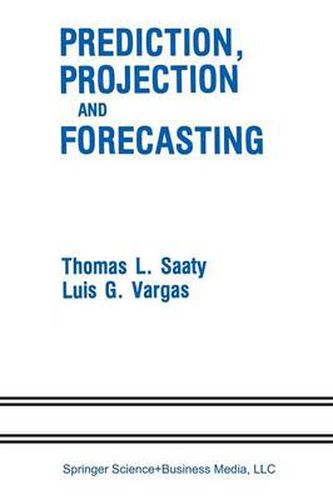Readings Newsletter
Become a Readings Member to make your shopping experience even easier.
Sign in or sign up for free!
You’re not far away from qualifying for FREE standard shipping within Australia
You’ve qualified for FREE standard shipping within Australia
The cart is loading…






This title is printed to order. This book may have been self-published. If so, we cannot guarantee the quality of the content. In the main most books will have gone through the editing process however some may not. We therefore suggest that you be aware of this before ordering this book. If in doubt check either the author or publisher’s details as we are unable to accept any returns unless they are faulty. Please contact us if you have any questions.
We predict when we say in advance, foretell, or prophesy what is likely to happen in the future. We project when we calculate the numerical value associated with a future event. We forecast, a special kind of prediction, on data of past happenings to generate or cast data for future by relying happenings. Generally, one predicts (yes, no) a war, an earthquake or the outcome of a chess match, projects the value of the GNP or of unemployment, and forecasts the weather and, more scientifically, the economic trends. Prediction, projection, and forecasting must be constrained in time and space: when and where. Often the accuracy of a forecast is of interest along with how sensitive the outcome is to changes in the factors involved. Is there a basis for improving the wisdom we need to make correct and useful predictions? We believe there is, and that it can be cultivated by studying the approach given here along with the various examples. To the best of our knowledge, no other work has approached prediction in the scientific framework of hierarchies. Prediction is the synthesis of past and present in an attempt to foretell the future. In our view, creation is not the ultimate phenomenon of the world. Nature creates forms and so do we. The problem is to surmise the eventual purpose, impact, and use of creation. It is the synthesis or outcome of bringing together the results of creation that we need to predict.
$9.00 standard shipping within Australia
FREE standard shipping within Australia for orders over $100.00
Express & International shipping calculated at checkout
This title is printed to order. This book may have been self-published. If so, we cannot guarantee the quality of the content. In the main most books will have gone through the editing process however some may not. We therefore suggest that you be aware of this before ordering this book. If in doubt check either the author or publisher’s details as we are unable to accept any returns unless they are faulty. Please contact us if you have any questions.
We predict when we say in advance, foretell, or prophesy what is likely to happen in the future. We project when we calculate the numerical value associated with a future event. We forecast, a special kind of prediction, on data of past happenings to generate or cast data for future by relying happenings. Generally, one predicts (yes, no) a war, an earthquake or the outcome of a chess match, projects the value of the GNP or of unemployment, and forecasts the weather and, more scientifically, the economic trends. Prediction, projection, and forecasting must be constrained in time and space: when and where. Often the accuracy of a forecast is of interest along with how sensitive the outcome is to changes in the factors involved. Is there a basis for improving the wisdom we need to make correct and useful predictions? We believe there is, and that it can be cultivated by studying the approach given here along with the various examples. To the best of our knowledge, no other work has approached prediction in the scientific framework of hierarchies. Prediction is the synthesis of past and present in an attempt to foretell the future. In our view, creation is not the ultimate phenomenon of the world. Nature creates forms and so do we. The problem is to surmise the eventual purpose, impact, and use of creation. It is the synthesis or outcome of bringing together the results of creation that we need to predict.